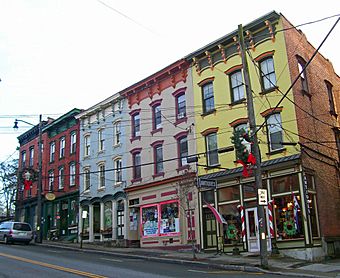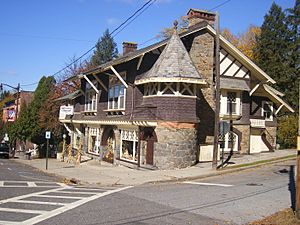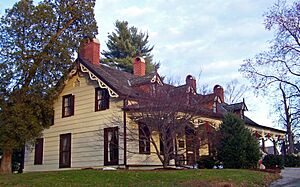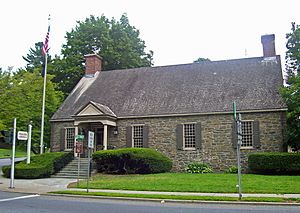Wappingers Falls Historic District facts for kids
Quick facts for kids |
|
|
Wappingers Falls Historic District
|
|

Civil War-era rowhouses on east side of Main, 2007
|
|
| Location | Wappingers Falls, NY |
|---|---|
| Nearest city | Poughkeepsie |
| Area | 90 acres (36 ha) |
| Built | mid 18th-mid 20th century |
| Architectural style | Late Victorian |
| MPS | Wappingers Falls MRA |
| NRHP reference No. | 84002380 |
| Added to NRHP | 1984 |
The Wappingers Falls Historic District is a special area in the middle of Wappingers Falls village. This village is located in Dutchess County, New York, in the United States. The district covers about 90 acres (36 hectares). It is mainly found around South Avenue and West Main Street, which is also NY 9D, and near the Wappinger Creek.
This historic area includes Mesier Park, which is right in the center of the village. It also covers many nearby neighborhoods with homes. These areas are roughly bordered by Elm, Park, Walker, Market, and McKinley streets. Most of the buildings in the district were built when Wappingers Falls became an important industrial town in the 1800s. Their building styles show the different looks popular during that century. However, the district also has older buildings, like the Mesier-Brewer House from around 1740. There are also newer ones, such as the Village Hall. This building used to be a post office and was designed under the direction of President Franklin D. Roosevelt.
Contents
How Wappingers Falls Grew Over Time
In 1819, a small factory that made cotton fabric was built. It was located in the valley where the Wappinger Creek flows down from Lake Wappinger into the nearby Hudson River. By 1856, this factory had become one of the biggest fabric printing businesses in the entire country.
That same year, a fire completely destroyed the original factory buildings. But they were quickly rebuilt and kept running until 1931. The streets on the hillside across from the factory are still lined with wooden houses. Most of these were duplexes, meaning they had two separate homes in one building. The factory built these homes for its workers.
The two parts of the district, and the village itself, are connected by a strong stone arch bridge. This bridge was built in 1884. It replaced older bridges made of wood.
The main business area of the village is along Main Street, both north and south of the creek. Here, you will find many three-story buildings with an Italianate style. These buildings were built in the years after the Civil War.
The residential streets to the southwest have larger homes. These houses show off many different building styles from the 1800s. You can see styles like Greek Revival and Gothic Revival. There are also homes built in the Second Empire and Queen Anne styles.
Two very important buildings in the district are listed separately on the National Register of Historic Places. These buildings come from different times in the village's history. The Mesier-Brewer House is in the center of the village. It is a very old and well-kept home made of stone and wood. It was built before the Revolutionary War.
Across from the Mesier-Brewer House, where East Main Street and South Avenue meet, is the fieldstone building that now serves as the police station. This building was originally built as a post office. It was one of five post offices in the county that President Franklin D. Roosevelt insisted be built from stone. He was from nearby Hyde Park. Later, a new post office was built a few blocks away. In 1995, the village government moved its offices into this old post office building. The police, who had been working from the Mesier House, also moved in.
In 1984, the Wappingers Falls Historic District was added to the National Register of Historic Places. It is described as a group of unique buildings from the 1800s. These buildings show how an important industrial center in the Hudson Valley grew and developed.
Buildings That Are No Longer Here
Some important buildings that were once part of the village's history are no longer standing.
Goring Hall's Story
Edward M. Goring was born in England in 1828. He came to America with his parents when he was eight years old. He went to school in Wappingers Falls. Later, he learned the skill of engraving for fabric printing. He worked in this field for many years.
Mr. Goring was involved in many important things in Wappingers Falls. He helped create the town of Wappinger. He also helped start the Wappingers Savings Bank and the Bank of Wappingers. He was also involved in making Wappingers Falls an official village. For a time, he was the postmaster for the village. He was also a trustee for the Grinnell Library for 30 years.
Goring Hall was built in 1872. It first opened as a store selling medicine and stationery. For over 20 years, it was home to the Falls Coffee Shop. This shop was run by Mary Ross, who was also the mayor of the village from 2001 to 2003. The coffee shop was known for giving coffee to volunteer firefighters when they responded to calls. Sadly, Goring Hall was torn down in December 2012. This happened after part of its wall collapsed in November 2012.
The Mulhern House
The Mulhern House was an old home located at the end of Market Street. It was built around 1815. This house was special because it was a worker's home that stayed mostly the same from the very first days of industry in Wappingers Falls. It was added to the National Register of Historic Places in 1987. However, the building was destroyed in a gas explosion in February 1994.
The Sweet Orr Factory
Clayton E. Sweet was born in Wappingers Falls in 1834. His father was a merchant and manufacturer in the village for many years. Clayton went to local schools and then worked in New York City. He later returned to Wappingers Falls to join his father's business.
Mr. Sweet became a very important businessman in the village. He helped start the Wappingers Savings Bank. He was also the postmaster for the village for seven years under President Grant.
The company Sweet, Orr & Co. was one of the first to make overalls. After doing a lot of business in Wappingers Falls, Clayton Sweet moved the company's main offices to Newburgh in 1887. The Sweet Orr company had a factory building on Mill Street in Wappingers Falls in the late 1800s. This factory made denim overalls and jeans that were sold all over the country. The building burned down in the 1990s. Now, that spot is one of the village's parking lots.
Images for kids
- NRHP inventory-nomination form 1984







